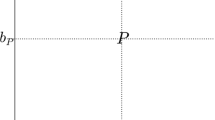Abstract
It is argued that the Tractatus Project of Logical Atomism, in which the world is conceived of as the totality of independent atomic facts, can usefully be understood by conceiving of each fact as a bit in ‘logical space’. Wittgenstein himself thinks in terms of logical space. His ‘elementary propositions’, which express atomic facts, are interpreted as tuples of co-ordinates which specify the location of a bit in logical space. He says that signs for elementary propositions are arrangements of names. Here, the names are understood as numerical symbols specifying coordinates. It is argued that, using this approach, the so-called ‘colour-exclusion’ problem, which was Wittgenstein’s reason for abandoning the Tractatus, is in fact soluble. However, if logical space is a continuum then some coordinates will need to be expressed by numerical symbols that are infinite in size. How is this to be understood in Tractatus terms? It is shown that, in the Tractatus, Wittgenstein did recognise the possibility of infinite propositions and sentences expressing them. At first sight his approach to infinite sentences, and the approach of the present paper, seem to differ, but it is argued that the difference is superficial. Finally, we address the question of whether Logical Atomism is viable and this raises issues concerning its relationship to natural science.
Similar content being viewed by others
References
Austin, J. (1980), ‘Wittgenstein's Solutions to the Colour Exclusion Problem’, Philosophy and Phenomenological Research 41(1–2).
Davidson, D. (2001), Essays on Actions and Events, 2nd edn, Oxford University Press.
Deutsch, D. (2002), ‘The Structure of the Multiverse’, Proc. R. Soc. Lond. 458(2028), pp. 2911–2923.
Kragh, H. (1999), Quantum Generations, Princeton: Princeton University Press.
Monk, R. (1991), Ludwig Wittgenstein, the Duty of Genius, Vintage.
Ramsey, F. (1923), ‘Tractatus Logico-Philosophicus’, Mind 32(128), pp. 465–478.
van Fraassen, B. (1991), Quantum Mechanics, O.U.P.: Oxford.
Wittgenstein, L. (1922), Tractatus Logic-Philosophicus, New York: Keagan Paul.
Wittgenstein, L. (1966), ‘Some Remarks on Logical Form’, in Copi and Beard, eds, Essays on Wittgenstein's Tractatus, New York: Routledge and Kegan Paul, pp. 31–37.
Wittgenstein, L. (1975), Philosophical Remarks, Blackwell, trans. Hargreaves and White.
Author information
Authors and Affiliations
Rights and permissions
About this article
Cite this article
Young, R. Wittgenstein’s Tractatus Project as Philosophy of Information. Minds and Machines 14, 119–132 (2004). https://doi.org/10.1023/B:MIND.0000005139.33126.78
Issue Date:
DOI: https://doi.org/10.1023/B:MIND.0000005139.33126.78




